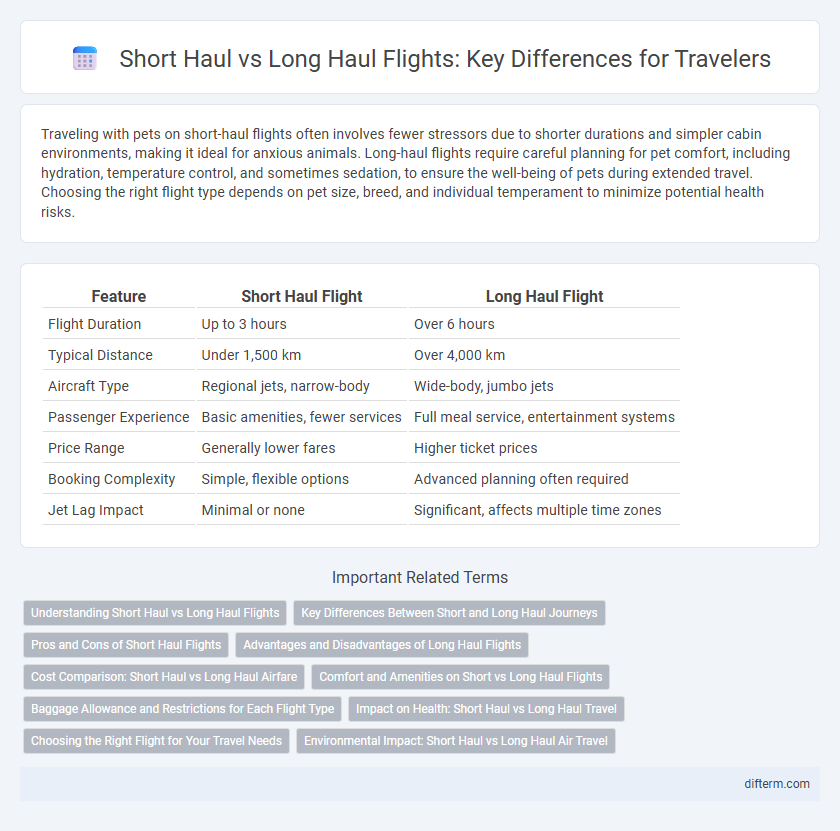Traveling with pets on short-haul flights often involves fewer stressors due to shorter durations and simpler cabin environments, making it ideal for anxious animals. Long-haul flights require careful planning for pet comfort, including hydration, temperature control, and sometimes sedation, to ensure the well-being of pets during extended travel. Choosing the right flight type depends on pet size, breed, and individual temperament to minimize potential health risks.
Table of Comparison
| Feature | Short Haul Flight | Long Haul Flight |
|---|---|---|
| Flight Duration | Up to 3 hours | Over 6 hours |
| Typical Distance | Under 1,500 km | Over 4,000 km |
| Aircraft Type | Regional jets, narrow-body | Wide-body, jumbo jets |
| Passenger Experience | Basic amenities, fewer services | Full meal service, entertainment systems |
| Price Range | Generally lower fares | Higher ticket prices |
| Booking Complexity | Simple, flexible options | Advanced planning often required |
| Jet Lag Impact | Minimal or none | Significant, affects multiple time zones |
Understanding Short Haul vs Long Haul Flights
Short haul flights typically cover distances under 3,000 kilometers and last up to three hours, making them ideal for regional travel and quick getaways. Long haul flights exceed 3,000 kilometers and often last over six hours, connecting distant cities across continents with amenities adapted for passenger comfort during extended travel. Understanding the distinctions in flight duration, distance, and service offerings helps travelers plan efficient itineraries and choose flights that best suit their needs.
Key Differences Between Short and Long Haul Journeys
Short haul flights typically cover distances under 3,000 kilometers and last up to 3 hours, offering quicker boarding and less in-flight service. Long haul flights exceed 6,000 kilometers and can last 7 hours or more, requiring comprehensive meal services, entertainment systems, and greater cabin comfort. Differences in aircraft type, baggage allowance, and jet lag effects are significant factors influencing passenger experience on short versus long haul journeys.
Pros and Cons of Short Haul Flights
Short haul flights, typically covering distances under 3,000 kilometers, offer the advantage of shorter travel times and often lower ticket prices, making them ideal for quick business trips or weekend getaways. These flights usually operate from smaller airports with streamlined boarding processes, reducing overall travel stress and wait times. However, frequent short haul flights can result in increased carbon emissions per kilometer, and the limited in-flight services may offer less comfort compared to long haul options.
Advantages and Disadvantages of Long Haul Flights
Long haul flights offer the advantage of reaching distant destinations without multiple layovers, saving overall travel time and providing a more direct route for international travelers. However, they often come with disadvantages such as increased passenger fatigue, jet lag due to crossing multiple time zones, and higher costs related to fuel consumption and onboard services. Airlines may provide enhanced comfort and entertainment options on long haul flights to mitigate these challenges, but extended periods of immobility still pose health risks like deep vein thrombosis.
Cost Comparison: Short Haul vs Long Haul Airfare
Short haul flights typically incur lower base fares due to shorter distances and quicker turnaround times, making them more cost-effective for budget-conscious travelers. Long haul airfare often includes higher operating costs like fuel, crew wages, and airport fees, which substantially increase ticket prices. Analyzing airline pricing models reveals that short haul routes frequently offer more promotions and flexible fare classes compared to the complex pricing algorithms driving long haul flight costs.
Comfort and Amenities on Short vs Long Haul Flights
Short haul flights typically offer basic seating and limited in-flight amenities due to shorter travel durations, often providing only snacks and drinks. Long haul flights prioritize passenger comfort with larger seats, enhanced legroom, entertainment systems, and complimentary meals to accommodate extended travel time. Airlines may also offer amenities such as blankets, pillows, and noise-canceling headphones on long haul journeys to improve overall passenger experience.
Baggage Allowance and Restrictions for Each Flight Type
Short haul flights typically offer a standard cabin baggage allowance of around 7-10 kg with stricter weight limits on checked luggage, often capped at 15-20 kg. Long haul flights generally provide more generous baggage allowances, permitting around 23-32 kg per checked bag and allowing multiple pieces depending on the airline's policy. Passengers on long haul flights should also be aware of varying restrictions on carry-on dimensions and prohibited items, which tend to be more lenient compared to short haul carriers focused on quick turnaround times.
Impact on Health: Short Haul vs Long Haul Travel
Short haul flights typically cause less jet lag and lower risk of deep vein thrombosis (DVT) due to shorter cabin confinement and minimal time zone changes. Long haul travel significantly increases exposure to dry cabin air, leading to dehydration and fatigue, and elevates the risk of blood clots and muscle stiffness from prolonged immobility. Frequent long haul travelers should practice regular movement, hydrate thoroughly, and consider compression stockings to mitigate health risks.
Choosing the Right Flight for Your Travel Needs
Short haul flights, typically under 3 hours, offer convenience and cost-efficiency for domestic or regional travel, ideal for business trips and weekend getaways. Long haul flights, exceeding 6 hours, provide comprehensive international connectivity with enhanced amenities like in-flight entertainment and meal service, suitable for extended vacations or global business engagements. Evaluating factors such as travel duration, comfort preferences, and budget helps travelers select the most efficient and enjoyable flight option.
Environmental Impact: Short Haul vs Long Haul Air Travel
Short haul flights generate higher carbon emissions per kilometer traveled due to frequent takeoffs and landings, which consume more fuel relative to distance. Long haul flights are more fuel-efficient on a per kilometer basis but result in greater total emissions due to the extended distance covered. Airlines and travelers aiming to minimize environmental impact should consider the carbon intensity differences when choosing flight options.
short haul vs long haul flight Infographic

 difterm.com
difterm.com